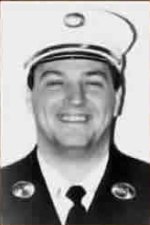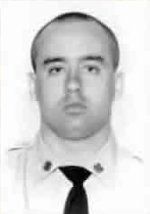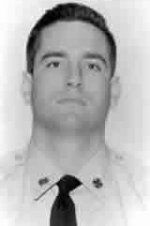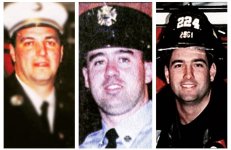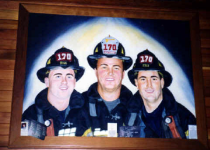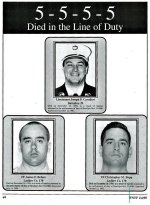
Three Fire Fighters Die in a 10-Story High-Rise Apartment Building - New York
 Death in the Line of Duty…A summary of a NIOSH fire fighter fatality investigation
Death in the Line of Duty…A summary of a NIOSH fire fighter fatality investigation
F99-01 Date Released: August 2, 1999
SUMMARY
On December 18, 1998, several fire companies and fire fighters responded at 0454 hours to a reported fire on the tenth floor of a 10-story high-rise apartment building for the elderly. The fire had been burning for 20 to 30 minutes before it was called in because the resident attempted to put the fire out with small pans of water. As the fire fighters approached the building from the rear, an orange glow was observed in the window of Apartment 10D. As the fire fighters were arriving in front of the high-rise, a call was received from Central Dispatch that a female resident in the apartment next door to the fire apartment was trapped in her apartment and needed help. Several fire fighters entered the lobby area, and some took the stairs to the ninth floor, while others took the elevator to the ninth floor. A Lieutenant and two fire fighters on Ladder 170 (the victims), along with the Lieutenant on Engine 290, took the B-stairs from the ninth floor to the tenth floor, and entered the hallway, in search of the fire, while 4 fire fighters on Engine 290 were flaking out the hose line on the ninth floor and in the stairwell between the ninth and tenth floor in preparation for hookup. During this same time period, other fire fighters had gone to the tenth floor A-stairwell landing to attempt a hose line hookup to the standpipe in the landing. Engine Company 257 fire fighters, who were attempting to make a hook-up on the fire floor landing, experienced trouble with the heat, heavy smoke, and heavy insulation on the standpipe and were forced to abandon this hook-up. The Lieutenant on Engine 290 and the victims, who were on the B-side, were approaching the center smoke doors (see diagram), when the Lieutenant radioed his driver on the outside, and asked, “Where is the fire?” The driver radioed back, the fire is in the rear, towards exposure 4. The Lieutenant on Engine 290 then left the tenth floor, descended the stairs to the ninth floor and helped his men drag the hose to the A-stairwell, where they met up with fire fighters on Engine 257, who assisted them in stretching their line and hook-up on the ninth floor. The victims proceeded through the center smoke doors in search of the fire. From the information obtained during this investigation, it is believed the victims found the fire apartment, with the door partially opened, allowing smoke and hot gases to enter the hallway. They then opened the door fully, the wind pushed the fire and extreme heat in the apartment into the hallway, and a flashover occurred, exposing the victims to extreme radiant heat that potentially elevated their body core temperature. The last radio transmission from the victims was a Mayday call. When the victims were found, all were unresponsive, they were treated at the scene and taken to the hospital where they were pronounced dead by the attending physician. NOTE: This building had sprinklers in the hallways, lobby, and basement, however, the valves on the first floor were closed, which shut off the water for the upper floors. NIOSH investigators concluded that to minimize similar occurrences, municipalities, city housing authorities, and building owners should:
- ensure that buildings equipped with sprinkler systems are operational
- consider early warning systems for timely notification of fire
NIOSH investigators also concluded that to minimize similar occurrences, fire departments should:
- ensure communications on the fireground are utilized and recorded, especially between fire fighters in IDLH situations and Incident Command
- ensure standpipe hookup is on the floor below the fire floor.
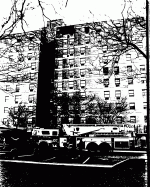
INTRODUCTION
On December 18, 1998, several fire fighters were involved in conducting an interior attack in a 10-story, Class 1, masonry high-rise for the elderly, when three fire fighters (the victims) on the tenth floor, who were trying to locate the fire, were subjected to extreme radiant heat from a flashover in the hallway in the vicinity of the fire apartment. A Lieutenant (Victim #1) and 2 fire fighters (Victims #2 and #3) from Ladder 170 had entered the tenth floor hallway from the B-stairwell (see diagram) and were proceeding down the hall, through the fire doors in an attempt to locate the fire, which was in Apartment 10D. Since all three fire fighters died and there were no witnesses, it is believed they located the fire apartment (10D) and when they opened the door, the apartment was fully involved in a flashover condition, subjecting all three fire fighters to an intensity of radiant heat that potentially elevated their body core temperature. During the time the victims were searching for the fire, the fire had vented itself out the apartment window, allowing the wind, 15 mph, gusting to 26 mph, to escalate the fire in the apartment. NOTE: Although this apartment building is owned and inspected by the city housing authority, has sprinklers in the hallways, basement, and lobby, and the yearly inspections conducted by the city indicate the system to be operative, the valves to the upper floors where concealed in the ceiling of the first floor hallway and had been shut off.
On January 13-15, 1999, and March 24, 1999, an investigation of this incident was conducted by the NIOSH Senior Fire Fighter Investigator and two Safety and Occupational Health Specialists. An opening conference was conducted with the Safety Operating Battalion, the Chief of Safety, the Occupational Safety and Health Coordinator, and the International Association of Fire Fighters (IAFF) Uniformed Officers and fire fighter representatives. Interviews were conducted with the Battalion Chiefs who responded to the incident, several fire fighters that responded to the incident, and representatives (officers and fire fighters) of the IAFF. A site visit was conducted and photographs were taken of the fire apartment and the exterior of the building. Copies of photographs from the incident site were obtained from the fire department along with diagrams of the building. Diagrams and pictures used in this report were provided by the fire department.
The fire department involved in the incident serves a population of 7.9 million in a geographic area of 306 square miles. The fire department has 230 firehouses and is comprised of approximately 15,000 employees, including 11,000 fire fighters and officers, 3,000 emergency medical service (EMS personnel), and 1,000 civilians. The fire department provides all new fire fighters with a basic 13 weeks of training at their fire academy that meets or exceeds the National Fire Protection Association (NFPA) Fire Fighter Level I and Level II. After graduating from the fire academy, the recruit fire fighters go through a 3-year rotation in which they are assigned to an A (high activity level), B (moderate activity level), or C (light activity level) firehouse for 1 year. They are then rotated to a different activity and geographic location for the second year and rotated again for the third year. Refresher training continues on each shift and multi-unit drills are conducted continually to maintain hands-on proficiency. The fire department has extensive written standard operating procedures. The Lieutenant (Victim #1) had 14 years of fire fighting experience, and the fire fighters (Victims #2 and #3) had 6 years and 3 years of fire fighting experience respectively.
Although many fire companies were involved in this four-alarm incident, only those directly involved up to the time of the fatal incident are discussed in this report.
INVESTIGATION
On December 18, 1998, at 0454 hours, a call came into Central Dispatch from a resident in Apartment 10G in a 10-story high-rise apartment building, stating she smelled smoke and observed fire in the apartment across the hall. The fire was also called in by the security guard for the apartment complex.
Responding to the first alarm at 0455 hours: Engine 257 (Lieutenant and four fire fighters), Engine 290 (Lieutenant and five fire fighters), Engine 283 (Lieutenant and five fire fighters), Ladder 170 (Lieutenant and five fire fighters [Lieutenant and two fire fighters were victims]), Ladder 103 (Captain and five fire fighters), Rescue 2 (Lieutenant and five fire fighters), and Battalion Chief (BC) 58 with aide, and Squad 252 (Captain and five fire fighters).
At 0458 hours, BC 58 and Engine 290 were approaching the apartment building from exposure 3 (rear of the building), and observed an orange glow in the window of an apartment on the tenth floor. At approximately the same time, Ladder 170, Engine 257, and Ladder 103 took positions on exposure 1 (front of the building). At approximately 0458 hours, a female in Apartment 10E called Central Dispatch and stated she was trapped in her apartment and needed help. Central Dispatch notified Ladder Company 103 and Ladder Company 170 that a woman was trapped in Apartment 10E. Both Companies acknowledged this transmission from the Dispatcher.
The Captain and two fire fighters on Ladder 103 were responding to the report that a woman was trapped in Apartment 10E. They took the A-stairwell to the tenth floor, which is the closest stairs to Apartment 10E. The Captain and one of the fire fighters on Ladder 103 removed the resident from Apartment 10E, and carried her with the assistance of the driver on Ladder 170, to the ninth floor.
At 0501 hours, BC 58 entered the lobby and saw Engine 257 fire fighters waiting for the elevator. He then took the A-stairs to the ninth floor and entered apartment 9D, looked out the window and saw the fire had vented out of the tenth floor window above. During this time, Engine 257 crew had taken the elevator to the ninth floor and proceeded down the hallway and took the A-stairs to the tenth floor, whereby they attempted to hook-up their 2 ½ inch line to the standpipe on the tenth floor stairwell landing. However, the fire fighters were having trouble hooking-up the line because of the insulation on the standpipe. The Lieutenant on Engine 257 opened the door to the tenth floor hallway and intense heat forced the fire fighters at the standpipe to abandon further hook-up efforts at this standpipe.
At 0502 hours, the driver on Ladder 170 had entered the lobby and took the A-stairs to the tenth floor where he met the Roof Man from Ladder 103. They descended down the stairs to the ninth floor and crossed over to the B-stairwell, went up the B-stairs to open the roof access door. The Roof Man on Ladder 103 decided to try the roof access from the B-stairwell. He then proceeded to the B-stairwell (driver of Ladder 170 is no longer with him) and found the roof access door open, and the Ladder 170 Roof Man was already on the roof. Both fire fighters were having trouble on the roof because of the gusting 26 mile-per-hour winds.
During this same time period, the Lieutenant and 2 fire fighters (victims) from Ladder 170 entered the lobby with the Lieutenant, nozzleman, and controlman from Engine 290 and took the elevator to the ninth floor. Two fire fighters from Engine 290 took the B-stairway (see diagram) to the ninth floor where they met up with their Lieutenant and the victims. The victims along with the Lieutenant from Engine 290 took the B-stairs to the tenth floor, whereby, they entered the hallway on the tenth floor and observed only a light haze, and no fire. The four fire fighters from Engine 290 remained on the ninth floor, B-side landing, were flaking-out three, 50-foot lengths of 2 ½-inch hose lines in preparation for hooking up to the ninth floor standpipe outlet. At 0503 hours, the Lieutenant on Engine 290 radioed the driver of Engine 290 from the tenth floor B-side hallway, and asked, “Where is the fire?” The driver radioed back, “The fire is in the rear, towards exposure 4.” The Lieutenant on Engine 290 relayed this information to Victim #1 who was near the center smoke doors attempting to locate the fire. The Lieutenant on Engine 290 then left the tenth floor, went down the B-stairs to the ninth floor, and along with four of the fire fighters from Engine 290, pulled the hose line to the A-stairwell to hook up and advance the line to the tenth floor.
After assisting the fire fighters on Ladder 103 carry the woman to the ninth floor, the driver on Ladder 170 proceeded down the hall toward the B-stairwell. On his way, he radioed his Lieutenant (Victim #1) who was attempting to find the fire on the tenth floor and asked if everything was alright. The Lieutenant radioed back, “We are having trouble with the door.” The driver of Ladder 170 then proceeded to the B-stairwell where he met the Captain from Squad 252 and fire fighters from Rescue 2.
Engine 257 fire fighters were on the tenth floor, A-stairwell, attempting to make a hookup, which was not successful because of the insulation on the standpipe, difficulty with the valve, lack of a control wheel, and the high heat and heavy smoke pushing from the public hallway. Engine 290 had connected on the ninth floor, A-stairwell. The Lieutenant on 257 requested assistance from Engine 290 at the door on the tenth floor stairwell. Fire fighters on Engine 257 and Engine 290 with a charged line, opened the door to the tenth floor hallway and were driven back by intense heat.
At 0511 hours, the Lieutenant on Engine 290 heard a Mayday over his radio. BC 58 did not hear the first Mayday. BC 58 heard the second Mayday, but could not determine the location, and was told the Mayday came from the Ladder 170 Can Man (Victim #2) and he responded to the Mayday, but received no acknowledgment.
At 0512 hours, BC 58 ordered Engine 283 to pull a line from the eighth floor to the tenth floor in the A-stairwell. Fire fighters on Engine 283 pulled a line from the eighth floor standpipe to the tenth floor stairwell landing.
At 0513 hours, on a third attempt, fire fighters from Engines 290, 257, and 283, with two charged lines (2 1/2-inch and 1 3/4-inch), in full open position, entered the tenth floor A-hallway door, and moving very slowly because of the extreme heat and zero visibility, proceeded towards the fire apartment, 10D (approximately 40 feet inside the stairwell door). Fire fighters on Engines 290 and 283 were running low on air and were replaced by fire fighters on Rescue 2. As they were approaching the fire apartment, they observed flames leaping out across the hall. The Lieutenant on Rescue 2 heard a Personal Alert Safety System (PASS) alarm sounding beyond the fire apartment (all PASS devices used by this fire department are integrated with the self-contained breathing apparatus [SCBA], i.e, when a fire fighter turns on his air, the PASS device is activated) He went to investigate, and within 20 feet from the fire apartment found Victim #1 (Lieutenant on Ladder Company 170) down and unresponsive. The Lieutenant on Rescue 2 discovered Victim #1 at 0528 hours, moved him toward the A-stairwell, left him, went for help, and completed the removal toward the B-stairway.
At 0518 hours, the Captain on Squad 252 and a fire fighter on Rescue 2 were proceeding down the tenth floor hallway, from the B-side towards the fire doors, when they opened the doors (see diagram) and found a helmet just inside the doors, then they found Victim #3 (first victim to be removed from the tenth floor), who was unresponsive. Victim #3 was removed from the tenth floor and taken to the ninth floor where he was given CPR and then transported to a local hospital where he was pronounced dead by the attending physician.
At 0525 hours, Victim #2 was found unresponsive by the driver of Ladder 175 and a fire fighter on Ladder 103. Victim #2 was removed to the ninth floor at 0529 hours, where he was worked by EMS and then transported to a local hospital where he was pronounced dead by the attending physician.
At approximately 0530 hours, BC 58 had gone to the roof to check rescue lines that were being laid and check conditions, i.e., civilians or fire fighters hanging out of windows, position of lines, and fire and wind conditions. BC 58 stated flames were coming up over the roof and were being blown across in a horizontal pattern by the strong gusting winds.
Victim #1 was the last to be removed from the tenth floor. He was taken to the ninth floor where he was worked by the EMS and transported to a local hospital where he was pronounced dead by the attending physician.
NOTE: From all the interviews conducted, the fire fighters who found Victims #2 and #3 cannot recall hearing the alarms of the PASS devices. The PASS alarm was heard on Victim #1, the Lieutenant on Ladder 170. All three PASS devices were tested by the fire department and found to be functioning.
CAUSE OF DEATH
According to the medical examiner, the preliminary cause of death listed for all three fire fighters was smoke inhalation and burns.
RECOMMENDATIONS/DISCUSSION
Recommendation #1: Municipalities, city housing authorities, and building owners should ensure that buildings equipped with sprinkler systems are operational. [1-4]
Discussion: This 10-story apartment building for the elderly was equipped with sprinklers in the hallways, basement, and lobby. The sprinkler system was inspected annually, however, without proper drawings for the system, it would be difficult to determine the location of piping and shut off valves. Although the system was inspected annually, it was never disclosed or discovered that there were shut-off valves concealed in the ceiling of the first floor hallway. It was apparent from the concealment, the valves had not been inspected in some time, since they were shut off, thereby, shutting off the water to all the upper floors.
Recommendation #2: Municipalities, city housing authorities, and building owners should consider early warning systems for timely notification of fire. [5, 6]
Discussion: It is important that an early detection system for a timely notification of fire be implemented, especially in high-rise apartment buildings to decrease the potential for loss of life and property. This fire had been burning for approximately 30 minutes before it was called into Central Dispatch. If this fire had been detected in the early stages, the fire department may have been able to extinguish the fire before it had escalated.
Recommendation #3: Fire departments should ensure communications on the fireground are utilized and recorded, especially between fire fighters in IDLH situations and Incident Command.
Discussion: Communications on the fireground are essential and provide the vital link between the fire fighters on the interior and Incident Command. Command receives communications from different sectors, i.e., fire fighters on the roof, exterior exposure reports, interior operations, location and any escalation of the fire, etc., and must make risk assessment decisions on a continual flow of information. When attempting to establish a time-line on the fireground, it would be beneficial to have communications recorded with an auto-time line to determine exactly what and when specific events occurred.[7]
Recommendation #4: Fire departments should ensure that the standpipe hookup is on the floor below the fire. [2]
It is recommended that when fire fighters are fighting a fire in high-rise buildings, they make connection to the standpipe on the floor below the fire floor. Although there were specific problems with the insulation on the standpipe, tenth floor, A-stairwell, the fire fighter also encountered problems due to the intense heat and smoke that was introduced in the stairwell every time the stairwell door was open.
INVESTIGATOR INFORMATION
This investigation was conducted by the following: Ted. A. Pettit, Senior Fire Fighter Investigator, Frank Washenitz and Kimberly Cortez, Safety and Occupational Health Specialist, NIOSH, Division of Safety Research.
REFERENCES
1. National Fire Protection Association [1996]. NFPA 13: Standard for the installation of sprinkler systems. Quincy, MA: National Fire Protection Association.
2. International Fire Service Training Association [1995]. Essentials of fire fighting 3rd ed. Stillwater, OK: Fire Protection Publications, Oklahoma State University.
3. National Fire Protection Association [1997]. NFPA: Fire protection handbook, 18 ed. Quincy, MA: National Fire Protection Association.
4. National Fire Protection Association [1998]. NFPA 25: Standard for inspection, testing, and maintenance of water-based fire protection systems. Quincy, MA: National Fire Protection Association.
5. National Fire Protection Association [1996]. NFPA 72: National fire alarm code. Quincy, MA: National Fire Protection Association.
6. National Fire Protection Association [1997]. NFPA 101: Code for safety to life from fire in buildings and structures. Quincy, MA: National Fire Protection Association.
7. Brunacini A. [1985] Fire command. Quincy, MA: National Fire Protection Association.
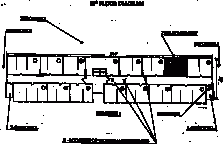
This page was last updated on 11/21/05
Three Fire Fighters Die in a 10-Story High-Rise Apartment Building - New York

www.cdc.gov
